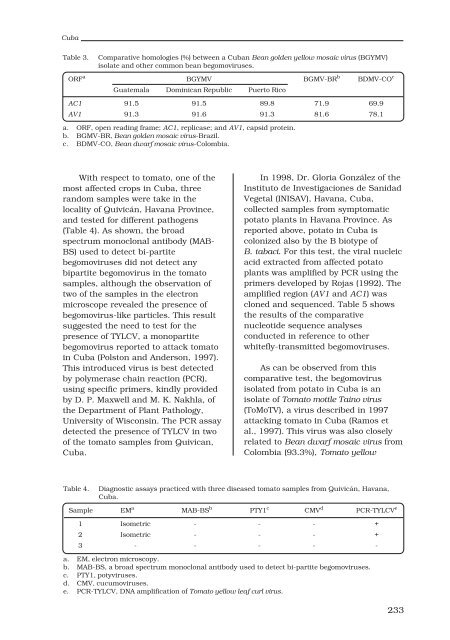Whitefly and whitefly-borne viruses in the tropics : Building a ... - cgiar
Whitefly and whitefly-borne viruses in the tropics : Building a ... - cgiar
Whitefly and whitefly-borne viruses in the tropics : Building a ... - cgiar
Create successful ePaper yourself
Turn your PDF publications into a flip-book with our unique Google optimized e-Paper software.
Cuba<br />
Table 3. Comparative homologies (%) between a Cuban Bean golden yellow mosaic virus (BGYMV)<br />
isolate <strong>and</strong> o<strong>the</strong>r common bean begomo<strong>viruses</strong>.<br />
ORF a<br />
BGYMV BGMV-BR b<br />
BDMV-CO c<br />
Guatemala Dom<strong>in</strong>ican Republic Puerto Rico<br />
AC1 91.5 91.5 89.8 71.9 69.9<br />
AV1 91.3 91.6 91.3 81.6 78.1<br />
a. ORF, open read<strong>in</strong>g frame; AC1, replicase; <strong>and</strong> AV1, capsid prote<strong>in</strong>.<br />
b. BGMV-BR, Bean golden mosaic virus-Brazil.<br />
c. BDMV-CO, Bean dwarf mosaic virus-Colombia.<br />
With respect to tomato, one of <strong>the</strong><br />
most affected crops <strong>in</strong> Cuba, three<br />
r<strong>and</strong>om samples were take <strong>in</strong> <strong>the</strong><br />
locality of Quivicán, Havana Prov<strong>in</strong>ce,<br />
<strong>and</strong> tested for different pathogens<br />
(Table 4). As shown, <strong>the</strong> broad<br />
spectrum monoclonal antibody (MAB-<br />
BS) used to detect bi-partite<br />
begomo<strong>viruses</strong> did not detect any<br />
bipartite begomovirus <strong>in</strong> <strong>the</strong> tomato<br />
samples, although <strong>the</strong> observation of<br />
two of <strong>the</strong> samples <strong>in</strong> <strong>the</strong> electron<br />
microscope revealed <strong>the</strong> presence of<br />
begomovirus-like particles. This result<br />
suggested <strong>the</strong> need to test for <strong>the</strong><br />
presence of TYLCV, a monopartite<br />
begomovirus reported to attack tomato<br />
<strong>in</strong> Cuba (Polston <strong>and</strong> Anderson, 1997).<br />
This <strong>in</strong>troduced virus is best detected<br />
by polymerase cha<strong>in</strong> reaction (PCR),<br />
us<strong>in</strong>g specific primers, k<strong>in</strong>dly provided<br />
by D. P. Maxwell <strong>and</strong> M. K. Nakhla, of<br />
<strong>the</strong> Department of Plant Pathology,<br />
University of Wiscons<strong>in</strong>. The PCR assay<br />
detected <strong>the</strong> presence of TYLCV <strong>in</strong> two<br />
of <strong>the</strong> tomato samples from Quivican,<br />
Cuba.<br />
In 1998, Dr. Gloria González of <strong>the</strong><br />
Instituto de Investigaciones de Sanidad<br />
Vegetal (INISAV), Havana, Cuba,<br />
collected samples from symptomatic<br />
potato plants <strong>in</strong> Havana Prov<strong>in</strong>ce. As<br />
reported above, potato <strong>in</strong> Cuba is<br />
colonized also by <strong>the</strong> B biotype of<br />
B. tabaci. For this test, <strong>the</strong> viral nucleic<br />
acid extracted from affected potato<br />
plants was amplified by PCR us<strong>in</strong>g <strong>the</strong><br />
primers developed by Rojas (1992). The<br />
amplified region (AV1 <strong>and</strong> AC1) was<br />
cloned <strong>and</strong> sequenced. Table 5 shows<br />
<strong>the</strong> results of <strong>the</strong> comparative<br />
nucleotide sequence analyses<br />
conducted <strong>in</strong> reference to o<strong>the</strong>r<br />
<strong>whitefly</strong>-transmitted begomo<strong>viruses</strong>.<br />
As can be observed from this<br />
comparative test, <strong>the</strong> begomovirus<br />
isolated from potato <strong>in</strong> Cuba is an<br />
isolate of Tomato mottle Ta<strong>in</strong>o virus<br />
(ToMoTV), a virus described <strong>in</strong> 1997<br />
attack<strong>in</strong>g tomato <strong>in</strong> Cuba (Ramos et<br />
al., 1997). This virus was also closely<br />
related to Bean dwarf mosaic virus from<br />
Colombia (93.3%), Tomato yellow<br />
Table 4. Diagnostic assays practiced with three diseased tomato samples from Quivicán, Havana,<br />
Cuba.<br />
Sample EM a<br />
MAB-BS b<br />
PTY1 c<br />
CMV d<br />
PCR-TYLCV e<br />
1 Isometric - - - +<br />
2 Isometric - - - +<br />
3 - - - - -<br />
a. EM, electron microscopy.<br />
b. MAB-BS, a broad spectrum monoclonal antibody used to detect bi-partite begomo<strong>viruses</strong>.<br />
c. PTY1, poty<strong>viruses</strong>.<br />
d. CMV, cucumo<strong>viruses</strong>.<br />
e. PCR-TYLCV, DNA amplification of Tomato yellow leaf curl virus.<br />
233
















